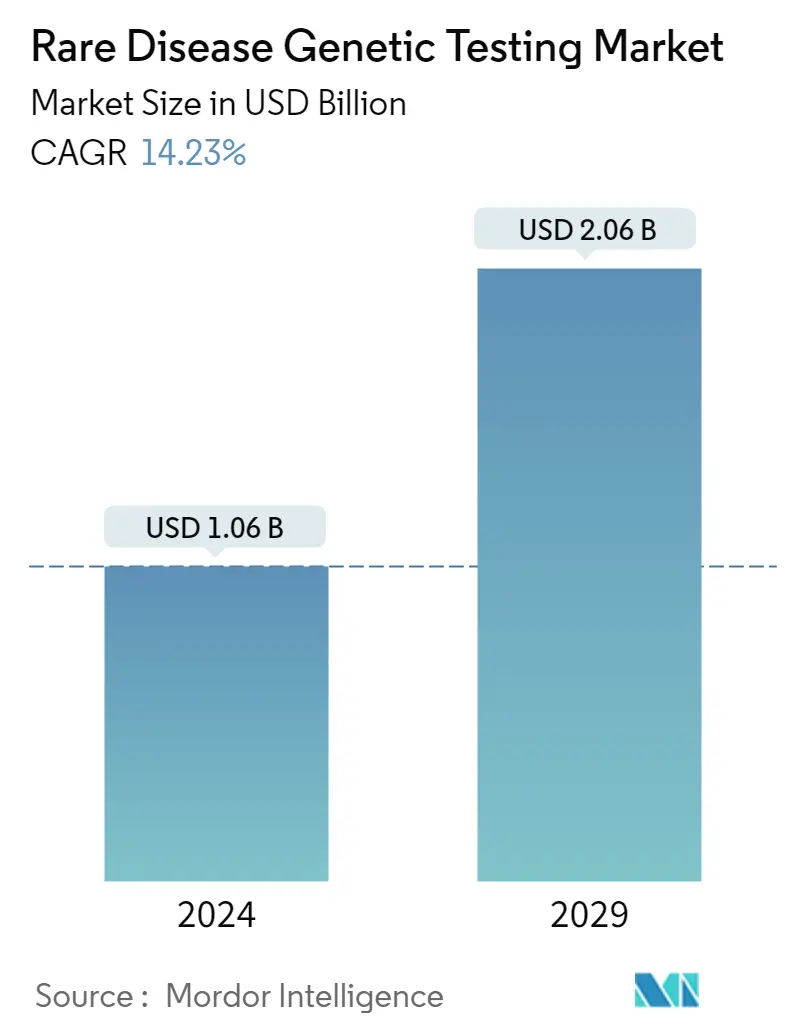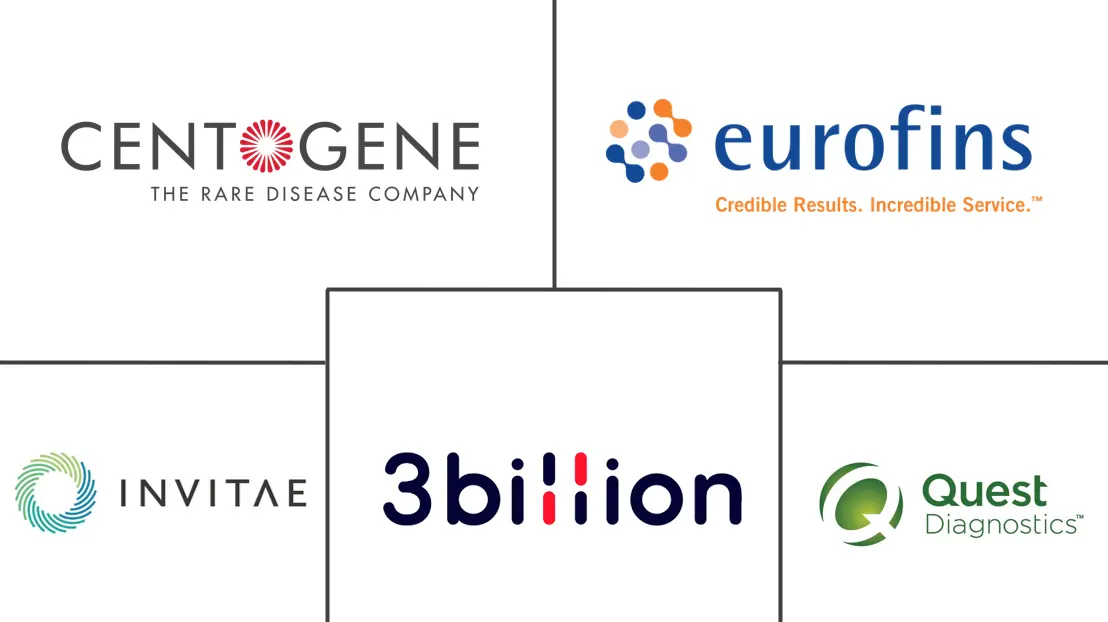Market Size of Rare Disease Genetic Testing Industry

| Study Period | 2021 - 2029 |
| Market Size (2024) | USD 1.06 Billion |
| Market Size (2029) | USD 2.06 Billion |
| CAGR (2024 - 2029) | 14.23 % |
| Fastest Growing Market | Asia Pacific |
| Largest Market | North America |
Major Players
*Disclaimer: Major Players sorted in no particular order |
Rare Disease Genetic Testing Market Analysis
The Rare Disease Genetic Testing Market size is estimated at USD 1.06 billion in 2024, and is expected to reach USD 2.06 billion by 2029, growing at a CAGR of 14.23% during the forecast period (2024-2029).
The COVID-19 pandemic impacted the rare disease genetic testing market. The rising number of COVID-19 cases resulted in global healthcare services shifting their resources toward COVID-19 care, which impacted patients with rare diseases. For instance, an article published in the Journal of Public Health, in March 2022, reported that there are between 5,000 and 8,000 rare diseases, most of them with a genetic basis. The article also reported that these rare diseases affect approximately 400 million people worldwide. Many ongoing research projects and clinical trials for rare and genetic diseases were stalled to avoid the transmission of COVID-19 among the patients and research staff. Thus, the pandemic led to a lack of healthcare services and cancellation of appointments, resulting in the underdiagnosis of rare disease patients. However, with the declining cases of COVID-19, the market started to recover at the pre-pandemic levels and is expected to continue the same over the forecast period.
The factors driving the growth of the market are expansion of the patient registry for rare diseases, developing genetic testing technologies, and increasing government initiatives for rare diseases.
The increasing number of available registries for rare diseases is driving the growth of the market. The purpose of rare disease patient registries is to better promote and support patient-focused rare disease research, which improves the foundation for therapy development and scientific understanding of a rare disease. For instance, an article published in March 2022 in the Journal Frontiers in Endocrinology reported that patient registries can fulfil multiple purposes for rare disease research, by improving the knowledge about natural history and variant disease courses and evaluating the safety, effectiveness, and long-term health benefits of preventive care programs, diagnostic strategies, and therapies, such as orphan drugs. Thus, patient registries are effective, convenient, and cost-efficient tools to support documentation of the natural history of a disease, centering patients as research partners for use within rare diseases. The rising number of patient registries is also driving the growth of the studied market.
In February 2022, Bionano Genomics launched a strategic initiative called Rare Undiagnosed Genetic Disease (RUGD) for the 350 million people globally living with rare diseases. Bionano's RUGD initiative includes its suite of product offerings, supporting educational awareness, working toward the development of research grants in this area, and supporting professional societies with a shared mission of improving RUGD patient care and management. As part of Bionano's RUGD initiative, the company has committed to providing three years of financial support for the ACMG Foundation for Genetic and Genomic Medicine (ACMGF) and its Next Generation Fellowship & Residency Training Awards Program in genetics and genomics. Thus, such initiatives are driving the growth of the studied market.
The new genetic testing technologies and the increasing government initiatives for rare disease testing are further propelling the growth of the studied market. For instance, in June 2022, the US FDA revealed its program for rare neurodegenerative diseases, a five-year strategy for extending and refining the lives of people suffering from rare diseases, by evolving the progress of effective and safe medical products and enabling patient access to innovative treatments.
Similarly, in January 2021, the UK Rare Disease Framework was launched, which focused on faster diagnosis, awareness, care, and access to treatment for 3.5 million rare disease patients over five years. Hence, the launch of new technologies, such as NGS-based genetic testing, and the increased demand for diagnosis and government initiatives are contributing to the growth of the rare disease genetic testing market.
Thus, due to the expanding patient registry for rare diseases and increasing government initiatives for the same, as well as the development of new genetic testing technologies, the studied market is expected to witness significant growth over the forecast period. However, a lack of awareness regarding rare diseases and technical challenges associated with genetic tests and data management may slow down the growth of the market.
Rare Disease Genetic Testing Industry Segmentation
As per the scope of the report, rare diseases are genetic disorders, and genetic testing is an advanced diagnostic tool that gives results within weeks.
The rare disease genetic testing market is expected to register a CAGR of 10% over the forecast period. The rare disease genetic testing market is segmented by technology (next-generation sequencing, array technology, PCR-based testing, FISH, and other technologies), disease (neurological disorders, immunological disorders, hematology diseases, endocrine and metabolism diseases, cancer, musculoskeletal disorders, and other diseases), end user (clinics/hospitals, diagnostic laboratories, and other end users), and geography (North America, Europe, Asia-Pacific, Middle East and Africa, and South America). The market report also covers the estimated market sizes and trends for 17 countries across major regions globally. The report offers the value (in USD million) for the above segments.
| By Technology | ||||
| ||||
| Array Technology | ||||
| PCR-based Testing | ||||
| FISH | ||||
| Other Technologies |
| By Disease | |
| Neurological Disorders | |
| Immunological Disorders | |
| Hematology Diseases | |
| Endocrine and Metabolism Diseases | |
| Cancer | |
| Musculoskeletal Disorders | |
| Other Diseases |
| By Geography | ||||||||
| ||||||||
| ||||||||
| ||||||||
| ||||||||
|
Rare Disease Genetic Testing Market Size Summary
The rare disease genetic testing market is poised for significant expansion, driven by advancements in genetic testing technologies, the proliferation of patient registries, and increased government initiatives. The market, which experienced disruptions due to the COVID-19 pandemic, is recovering and expected to grow robustly over the forecast period. The pandemic had previously diverted healthcare resources, impacting the diagnosis and treatment of rare diseases. However, as healthcare systems stabilize, the market is benefiting from strategic initiatives like Bionano Genomics' Rare Undiagnosed Genetic Disease program, which aims to enhance patient care and support research in this field. The development of new genetic testing technologies, such as next-generation sequencing, and supportive government policies are further propelling market growth, with regions like North America leading due to their high prevalence of rare diseases and substantial investments in research and development.
The whole-exome sequencing segment is anticipated to see substantial growth, attributed to its increasing application in clinical diagnostics and the rising demand for personalized medicine. This segment's expansion is supported by technological advancements that offer accurate and rapid results, as well as strategic activities by key players to enhance service offerings. North America is expected to witness significant market growth, bolstered by a robust healthcare infrastructure, extensive disease registries, and government support for clinical trials. The region's market growth is further fueled by strategic partnerships and technological developments, which enhance the availability and effectiveness of rare disease testing. Despite challenges such as lack of awareness and technical hurdles, the market's competitive landscape, characterized by numerous global and regional players, is set to drive continued growth and innovation in rare disease genetic testing.
Rare Disease Genetic Testing Market Size - Table of Contents
-
1. MARKET DYNAMICS
-
1.1 Market Overview
-
1.2 Market Drivers
-
1.2.1 Expanding Patient Registry for Rare Disease
-
1.2.2 Development in Genetic Testing Technologies
-
1.2.3 Increased Government Initiatives for Rare Diseases
-
-
1.3 Market Restraints
-
1.3.1 Lack of Awareness Regarding Rare Diseases
-
1.3.2 Technical Challenges Associated with Genetic Tests and Data Management
-
-
1.4 Porter's Five Forces Analysis
-
1.4.1 Threat of New Entrants
-
1.4.2 Bargaining Power of Buyers/Consumers
-
1.4.3 Bargaining Power of Suppliers
-
1.4.4 Threat of Substitute Products
-
1.4.5 Intensity of Competitive Rivalry
-
-
-
2. MARKET SEGMENTATION (Market Size by Value - USD million)
-
2.1 By Technology
-
2.1.1 Next-generation Sequencing
-
2.1.1.1 Whole Exome Sequencing (WES)
-
2.1.1.2 Whole Genome Sequencing (WGS)
-
-
2.1.2 Array Technology
-
2.1.3 PCR-based Testing
-
2.1.4 FISH
-
2.1.5 Other Technologies
-
-
2.2 By Disease
-
2.2.1 Neurological Disorders
-
2.2.2 Immunological Disorders
-
2.2.3 Hematology Diseases
-
2.2.4 Endocrine and Metabolism Diseases
-
2.2.5 Cancer
-
2.2.6 Musculoskeletal Disorders
-
2.2.7 Other Diseases
-
-
2.3 By Geography
-
2.3.1 North America
-
2.3.1.1 United States
-
2.3.1.2 Canada
-
2.3.1.3 Mexico
-
-
2.3.2 Europe
-
2.3.2.1 Germany
-
2.3.2.2 United Kingdom
-
2.3.2.3 France
-
2.3.2.4 Italy
-
2.3.2.5 Spain
-
2.3.2.6 Rest of Europe
-
-
2.3.3 Asia-Pacific
-
2.3.3.1 China
-
2.3.3.2 Japan
-
2.3.3.3 India
-
2.3.3.4 Australia
-
2.3.3.5 South Korea
-
2.3.3.6 Rest of Asia-Pacific
-
-
2.3.4 Middle East and Africa
-
2.3.4.1 GCC
-
2.3.4.2 South Africa
-
2.3.4.3 Rest of Middle East and Africa
-
-
2.3.5 South America
-
2.3.5.1 Brazil
-
2.3.5.2 Argentina
-
2.3.5.3 Rest of South America
-
-
-
Rare Disease Genetic Testing Market Size FAQs
How big is the Rare Disease Genetic Testing Market?
The Rare Disease Genetic Testing Market size is expected to reach USD 1.06 billion in 2024 and grow at a CAGR of 14.23% to reach USD 2.06 billion by 2029.
What is the current Rare Disease Genetic Testing Market size?
In 2024, the Rare Disease Genetic Testing Market size is expected to reach USD 1.06 billion.

